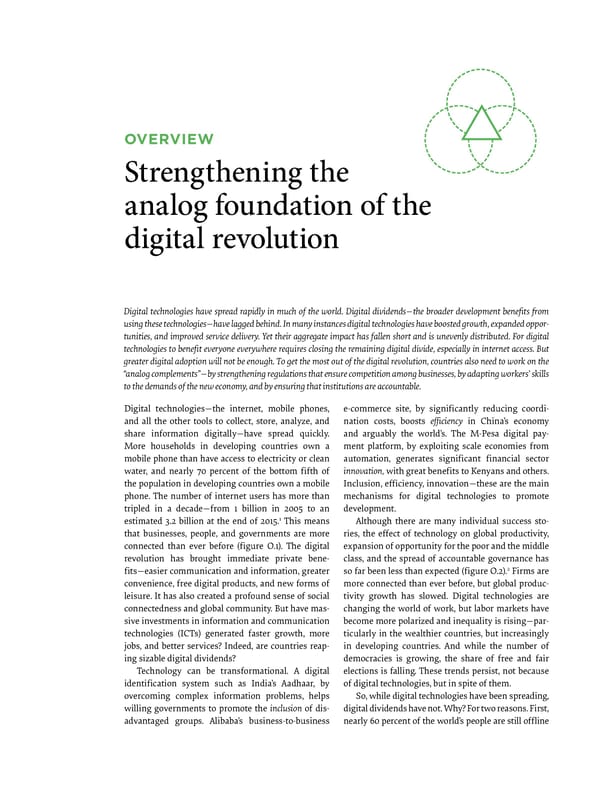OVERVIEW Strengthening the analog foundation of the digital revolution Digital technologies have spread rapidly in much of the world. Digital dividends—the broader development benefits from using these technologies—have lagged behind. In many instances digital technologies have boosted growth, expanded oppor- tunities, and improved service delivery. Yet their aggregate impact has fallen short and is unevenly distributed. For digital technologies to benefit everyone everywhere requires closing the remaining digital divide, especially in internet access. But greater digital adoption will not be enough. To get the most out of the digital revolution, countries also need to work on the “analog complements”—by strengthening regulations that ensure competition among businesses, by adapting workers’ skills to the demands of the new economy, and by ensuring that institutions are accountable. Digital technologies—the internet, mobile phones, e-commerce site, by significantly reducing coordi- and all the other tools to collect, store, analyze, and nation costs, boosts efficiency in China’s economy share information digitally—have spread quickly. and arguably the world’s. The M-Pesa digital pay- More households in developing countries own a ment platform, by exploiting scale economies from mobile phone than have access to electricity or clean automation, generates significant financial sector water, and nearly 70 percent of the bottom fifth of innovation, with great benefits to Kenyans and others. the population in developing countries own a mobile Inclusion, efficiency, innovation—these are the main phone. The number of internet users has more than mechanisms for digital technologies to promote tripled in a decade—from 1 billion in 2005 to an development. 1 estimated 3.2 billion at the end of 2015. This means Although there are many individual success sto- that businesses, people, and governments are more ries, the effect of technology on global productivity, connected than ever before (figure O.1). The digital expansion of opportunity for the poor and the middle revolution has brought immediate private bene- class, and the spread of accountable governance has 2 fits—easier communication and information, greater so far been less than expected (figure O.2). Firms are convenience, free digital products, and new forms of more connected than ever before, but global produc- leisure. It has also created a profound sense of social tivity growth has slowed. Digital technologies are connectedness and global community. But have mas- changing the world of work, but labor markets have sive investments in information and communication become more polarized and inequality is rising—par- technologies (ICTs) generated faster growth, more ticularly in the wealthier countries, but increasingly jobs, and better services? Indeed, are countries reap- in developing countries. And while the number of ing sizable digital dividends? democracies is growing, the share of free and fair Technology can be transformational. A digital elections is falling. These trends persist, not because identification system such as India’s Aadhaar, by of digital technologies, but in spite of them. overcoming complex information problems, helps So, while digital technologies have been spreading, willing governments to promote the inclusion of dis- digital dividends have not. Why? For two reasons. First, advantaged groups. Alibaba’s business-to-business nearly 60 percent of the world’s people are still offline
 World Development Report 2016 Page 12 Page 14
World Development Report 2016 Page 12 Page 14